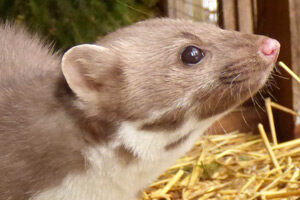Where do they live? In contrast from the European pine marten, beech marten prefer to reside in mosaic-type rural cultural landscapes bordering on small forest stand patches, as well as in rural villages, alleys, agricultural land, shrublands on river coasts and not far from residential areas.
How do they live? The lifestyle and habits of European pine marten and beech marten are very similar. Beech marten is also a sedentary animal that protects their territory from violators and marks their boundaries with faeces and urine. Monogamous couples are developed in spring before the mating period begins, then the couple is dissolved and only female martens take care of the cubs. The latent period of pregnancy starts after fertilisation. The fertilised egg remains inactive for almost ten months. Approximately one month before the birth of cubs, the development of the embryo resumes.
Beech martens are skilful climbers and love living in the trees, therefore, they are a threat to squirrels and other animals and birds that inhabit trees.
What do they eat? The list of items on the menu of beech marten is rather long. In contrast from European pine marten, they have much more plant-based food on their menu. However, apart from plant-based food, their menu includes various mouse-like rodents, birds and their eggs, squirrels, amphibians, reptiles, insects (mainly various beetle species), raspberries, bilberries and other berries, certain species of mushrooms, plant seeds, nuts, as well as carrion. Like European pine martens, beech martens also enjoy the cells and larvae in bee and wasp colonies, as well as their tasty honey.
How does one distinguish beech marten from European pine marten? The beech marten is comparatively shorter, but has a relatively longer tail, which gradually becomes narrower towards the tip. The ears of the beech marten are smaller, wider and more rounded. In contrast from the beech marten, in winter, the paws of European pine marten are always covered with fur on the inside. The fur of the beech marten, especially in summers, is lighter, paler and coarser – light grey-brown on the back, darker on the legs and tail. However, the main difference is the creamy-white patch under the throat – in beech martens it starts from the throat and, on its way down, separates into two parts, to the upper part of the front legs. Furthermore, the colour of the patch varies from white to pale-yellow, while in European pine marten, the colour of the patch is darker yellow, sometimes even almost orange. It starts from the throat and stretches down in a wedge shaped pattern into the dewlap.

